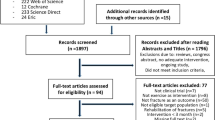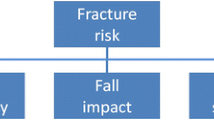Abstract
Summary
The EFOPS trial clearly established the positive effect of long-term exercise on clinical low-trauma fractures in postmenopausal women at risk. Bearing in mind that the complex anti-fracture exercise protocols also affect a large variety of diseases of increased age, we strongly encourage older adults to perform multipurpose exercise programs.
Introduction
Physical exercise may be an efficient option for autonomous fracture prevention during increasing age. The aim of the study was to evaluate the effect of exercise on clinical overall fracture incidence and bone mineral density (BMD) in elderly subjects at risk.
Methods
In 1998 initially, 137 early-postmenopausal, osteopenic women living in Erlangen-Nuremberg, Germany, were included in the EFOPS trial. Subjects of the exercise group (EG; n = 86) conducted two supervised group and two home exercise sessions/week while the control group (CG; n = 51) was requested to maintain their physical activity. Primary study endpoints were clinical overall low-trauma fractures determined by questionnaires, structured interviews, and BMD at the lumbar spine and femoral neck assessed by dual-energy X-ray absorptiometry.
Results
In 2014, 105 subjects (EG: n = 59 vs. CG: n = 46) representing 1680 participant-years were included in the 16-year follow-up analysis. Risk ratio in the EG for overall low-trauma fractures was 0.51 (95 % confidence interval (95 % CI) 0.23 to 0.97, p = .046), rate ratio was 0.42 (95 % CI 0.20 to 0.86, p = .018). Based on comparable baseline values, lumbar spine (MV −1.5 %, 95 % CI −0.1 to −2.8 vs. −5.8 %, −3.3 to −7.2 %) and femoral neck (−6.5 %, −5.2 to −7.7 vs. −9.6 %, −8.2 to 11.1 %) BMD decreased in both groups; however, the reduction was more pronounced in the CG (p ≤ .001).
Conclusion
This study clearly evidenced the high anti-fracture efficiency of multipurpose exercise programs. Considering furthermore the favorable effect of exercise on most other risk factors of increasing age, we strongly encourage older adults to perform multipurpose exercise programs.

Similar content being viewed by others
References
Burge R, Dawson-Hughes B, Solomon DH, Wong JB, King A, Tosteson A (2007) Incidence and economic burden of osteoporosis-related fractures in the United States, 2005–2025. J Bone Miner Res 22:465–475
Salkeld G (2000) Quality of life related to fear of falling and hip fracture in older women: a time trade off study. BMJ 320:341–346
Howe TE, Shea B, Dawson LJ, Downie F, Murray A, Ross C, Harbour RT, Caldwell LM, Creed G (2011) Exercise for preventing and treating osteoporosis in postmenopausal women. Cochrane Database Syst Rev CD000333
Marques EA, Mota J, Carvalho J (2011) Exercise effects on bone mineral density in older adults: a meta-analysis of randomized controlled trials. Age 34:1493–1515
Gillespie LD, Robertson MC, Gillespie WJ, Sherrington C, Gates S, Clemson LM, Lamb SE (2012) Interventions for preventing falls in older people living in the community. Cochrane Database Syst Rev 9:CD007146
Sherrington C, Tiedemann A, Fairhall N, Close JC, Lord SR (2011) Exercise to prevent falls in older adults: an updated meta-analysis and best practice recommendations. NSW Public Health Bull 22:78–83
Groen BE, Weerdesteyn V, Duysens J (2007) Martial arts fall techniques decrease the impact forces at the hip during sideways falling. J Biomech 40:458–462
Kemmler W, Haberle L, von Stengel S (2013) Effects of exercise on fracture reduction in older adults: a systematic review and meta-analysis. Osteoporos Int 24:1937–1950
Body JJ, Bergmann P, Boonen S, Boutsen Y, Devogelaer JP, Goemaere S, Kaufman JM, Rozenberg S, Reginster JY (2010) Evidence-based guidelines for the pharmacological treatment of postmenopausal osteoporosis: a consensus document by the Belgian Bone Club. Osteoporos Int 21:1657–1680
Shephard RJ (2002) Ethics in exercise science research. Sports Med 32:169–183
Sterne JA, Sutton AJ, Ioannidis JP et al (2011) Recommendations for examining and interpreting funnel plot asymmetry in meta-analyses of randomised controlled trials. BMJ 343:d4002
Kemmler W, von Stengel S (2011) Exercise and osteoporosis-related fractures: perspectives and recommendations of the sports and exercise scientist. Phys Sportmed 39:142–157
Kemmler W, Lauber D, Weineck J, Hensen J, Kalender W, Engelke K (2004) Benefits of 2 years of intense exercise on bone density, physical fitness, and blood lipids in early postmenopausal osteopenic women: results of the Erlangen Fitness Osteoporosis Prevention Study (EFOPS). Arch Intern Med 164:1084–1091
von Stengel S, Kemmler W, Kalender WA, Engelke K, Lauber D (2007) Differential effects of strength versus power training on bone mineral density in postmenopausal women: a 2-year longitudinal study. Br J Sports Med 41:649–655, discussion 655
Kemmler W, von Stengel S, Bebenek M, Engelke K, Hentschke C, Kalender WA (2012) Exercise and fractures in postmenopausal women: 12-year results of the Erlangen Fitness and Osteoporosis Prevention Study (EFOPS). Osteoporos Int 23:1267–1276
Kemmler W, Lauber D, Von Stengel S, Engelke K (2005) Developing maximum strength in older adults—a series of studies. In: Gießing J, Fröhlich M, Preuss P (eds) Current results of strength training research. Cuvillier Verlag, Göttingen, pp 114–133
Borg E, Kaijser L (2006) A comparison between three rating scales for perceived exertion and two different work tests. Scand J Med Sci Sports 16:57–69
DVO (2014) DVO-Leitlinien 2014 zur Prophylaxe, Diagnostik und Therapie der Osteoporose bei Männern ab dem 60. Lebensjahr und postmenopausalen Frauen, Schattauer
Kanis JA, McCloskey EV, Johansson H, Oden A, Strom O, Borgstrom F (2010) Development and use of FRAX in osteoporosis. Osteoporos Int 21(Suppl 2):S407–S413
Salamone LM, Dallal GE, Zantos D, Makrauer F, Dawson-Hughes B (1994) Contributions of vitamin D intake and seasonal sunlight exposure to plasma 25-hydroxyvitamin D concentration in elderly women. Am J Clin Nutr 59:80–86
Cohen J (1988) Statistical power analysis for the behavioral sciences. Lawrence Earlbaum Associate, Hillsdale
Kemmler W, von Stengel S (2014) Dose-response effect of exercise frequency on bone mineral density in post-menopausal, osteopenic women. Scand J Med Sci Sports 24:526–534
Kemmler W, Weineck J, Kalender WA, Engelke K (2004) The effect of habitual physical activity, non-athletic exercise, muscle strength, and VO2max on bone mineral density is rather low in early postmenopausal osteopenic women. J Musculoskelet Neuronal Interact 4:325–334
Moayyeri A (2008) The association between physical activity and osteoporotic fractures: a review of the evidence and implications for future research. Ann Epidemiol 18:827–835
Jansen JP, Bergman GJ, Huels J, Olson M (2011) The efficacy of bisphosphonates in the prevention of vertebral, hip, and nonvertebral-nonhip fractures in osteoporosis: a network meta-analysis. Semin Arthritis Rheum 40(275–284):e271–e272
Black DM, Delmas PD, Eastell R et al (2007) Once-yearly zoledronic acid for treatment of postmenopausal osteoporosis. N Engl J Med 356:1809–1822
McCloskey EV, Johansson H, Oden A, Austin M, Siris E, Wang A, Lewiecki EM, Lorenc R, Libanati C, Kanis JA (2012) Denosumab reduces the risk of osteoporotic fractures in postmenopausal women, particularly in those with moderate to high fracture risk as assessed with FRAX. J Bone Miner Res 27:1480–1486
Neer RM, Arnaud CD, Zanchetta JR (2001) Effect of parathyroid hormone (1–34) on fractures and bone mineral density in postmenopausal women with osteoporosis. N Engl J Med 344:1434–1441
Kemmler W, von Stengel S (2013) Exercise frequency, health risk factors, and diseases of the elderly. Arch Phys Med Rehabil 94:2046–2053
Jarvinen TL, Sievanen H, Khan KM, Heinonen A, Kannus P (2008) Shifting the focus in fracture prevention from osteoporosis to falls. BMJ 336:124–126
Moreland J, Richardson J, Chan DH, O'Neill J, Bellissimo A, Grum RM, Shanks L (2003) Evidence-based guidelines for the secondary prevention of falls in older adults. Gerontology 49:93–116
Rubenstein LZ, Josephson KR (2002) The epidemiology of falls and syncope. Clin Geriatr Med 18:141–158
Kelley GA, Kelley KS, Kohrt WM (2012) Effects of ground and joint reaction force exercise on lumbar spine and femoral neck bone mineral density in postmenopausal women: a meta-analysis of randomized controlled trials. BMC Musculoskelet Disord 13:177
Snow CM, Shaw JM, Winters KM, Witzke KA (2000) Long-term exercise using weighted vests prevents hip bone loss in postmenopausal women. J Gerontol A Biol Sci Med Sci 55:M489–M491
Shaw JM, Snow CM (1998) Weighted vest exercise improves indices of fall risk in older women. J Gerontol A Biol Sci Med Sci 53:M53–M58
Wallace BA, Cumming RG (2000) Systematic review of randomized trials of the effect of exercise on bone mass in pre- and postmenopausal women. Calcif Tissue Int 67:10–18
Rütten A, Abu-Omar K, Lampert T, Ziese T (2005) Körperliche Aktivität [Physical Activity]. Report. In: Robert-Koch-Institut (ed) Gesundheitsberichterstattung des Bundes. Statistisches Bundesamt, Berlin
Guglielmi G, Floriani I, Torri V, Li J, van Kuijk C, Genant HK, Lang TF (2005) Effect of spinal degenerative changes on volumetric bone mineral density of the central skeleton as measured by quantitative computed tomography. Acta Radiol 46:269–275
Sinaki M, Itoi E, Wahner HW, Wollan PC, Gelczer RK, Mullan BP, Collins DA, Hodgson SF (2002) Stronger back muscles reduce the incidence of vertebral fractures: a prospective 10-year follow-up of postmenopausal women. Bone 30:836–841
Börjesson M, Hellenius ML, Jansson E, Karlson J, Leijon M, Staehle A, Sundberg CJ, Taube T (2010) Physical activity in the prevention and treatment of disease. Swedish Institute of Health, Stockholm
Acknowledgments
We gratefully acknowledge the support of the nonprofit institutions “Behinderten und Rehabilitations Sportverband Bayern”, “Netzwerk Knochengesundheit,” and the Institute of Sport and Sport Science FAU Erlangen-Nuremberg. We also thank Sanofi-Synthelabo GmbH (Henning, Berlin, Germany) who supplied Ca and Vit D for the first five study years and the supply of elastic bands by TheraBand™ (Akron, Ohio, USA).
Conflicts of interest
None.
Author information
Authors and Affiliations
Corresponding author
Rights and permissions
About this article
Cite this article
Kemmler, W., Bebenek, M., Kohl, M. et al. Exercise and fractures in postmenopausal women. Final results of the controlled Erlangen Fitness and Osteoporosis Prevention Study (EFOPS). Osteoporos Int 26, 2491–2499 (2015). https://doi.org/10.1007/s00198-015-3165-3
Received:
Accepted:
Published:
Issue Date:
DOI: https://doi.org/10.1007/s00198-015-3165-3




